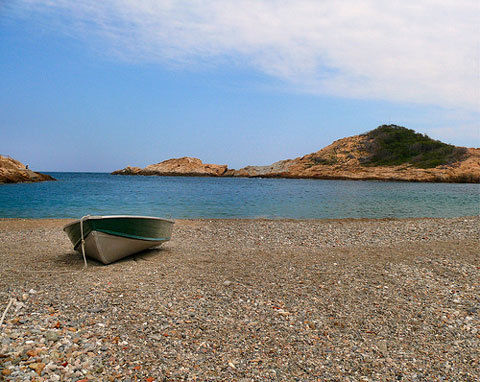
Gorgeous Coastline




In central Costa Brava, away from the larger resorts and just few minutes away from Mas Saline, you’ll find some of the most gorgeous, unspoilt, and romantic coastline in Europe. There are golden, sandy coves and award-winning, family-friendly beaches. You’re also on the Emporda region’s lush countryside – great for walking or cycling, with medieval villages to explore and some of the best food in the world to taste.
Platja Fonda, Sa Tuna, Sa Riera and Aigua Blava near Begur, Cala Tamariu and El Golfet near Calella are among several of the most beautiful coves along this coast. Alternatively, for large swathes of sand where the kids can run free, Pals Beach, is equally pretty, flanked by Medas Island natural reserve on the north and by pine tree-clad hills on the south side. Or there's the bay of Llafranc, with its yacht-filled harbour and restaurants. In Calella, the Cap Roig Botanical Gardens offer fabulous views of the surrounding coast, as does the "Cami de Ronda" – a winding coastal path edging along many of the Costa Brava's most stunning beaches.
The history trail
Almost as impressive as Pompeii, but far less well known is the sprawling complex of Greco-Roman ruins at Empuries – Spain’smost important archaeological site. With the coast just across the road and the Pyrenees in the distance, it’s also one of the most beautiful. Equally memorable is the medieval Jewish quarter, Arab baths and cathedral in Girona.
The retail therapy
The medieval town of La Bisbal is the centre of the local pottery industry and the place to come for terracotta dishes or vividly hand-painted ceramics, from plates and wall tiles to candlesticks and planters. For fresh food, meanwhile, and the ripest tomatoes you’ve ever seen, head for the weekly markets at Torroella de Montgri, Pals, Begur and Palafrugell.
The marine reserve
The Medes Islands (Illes Medes) are an archipelago of several islets covering one nautical mile of sea, just off the coastline of L’Estartit (fisherman's village just 7 miles away from the house), offering some of the best scuba diving. They are considered a top Mediterranean dive spot.
Jacques Cousteau came to the Illes Medes in 1955 to document the marine life, and noted that preservation of it’s rich ecosystem was essential. Thankfully, the Islands were made a marine nature reserve in 1990 protecting not only the islets themselves but also the sea below.
A confluence of nutrient-rich currents and upwelling feeds the dense fields of gorgonians and bright purple, red and yellow sea fans that blanket the rock formations, and thanks to their marine-preserve protections, the caverns and undersea pinnacles attract improbable numbers of fish. Huge grouper swim nonchalantly among the rocks while schooling bait fish mob the deeper sites with predatory pelagics like jacks and barracuda hot on their tails.
The Medes Islands offer, all year round, something for all levels of diver, with depths up to 50 metres, drop-offs and caves.
The places to eat and drink
The Emporda- Costa Brava is world known for its top level gastronomy and fresh slow food products. Just few miles away from Mas Saline you'll find some of the best restaurants in Spain , which we'll be pleased to short list to you. And of course, during your stay in Mas Saline, you should seriously consider visiting the recently crowned number one at The World's 50 Best Restaurants ceremony 2013: "El Celler de Can Roca" by our friends Josep, Joan and Jordi Roca in Girona.
High-level Summer Festivals
In summertime the Costa Brava becomes a land of festivals. The area is now home to four festivals that can be ranked as full-blown cultural and social events on account of their longstanding tradition and the high standards evinced in their programmes.
All in all, the summer will bring you a chance to hear and see live performances from prominent national and international figures.
The gardens of the castle and church of El Carme are the venues for the Peralada castle festival (Festival Castell de Peralada), at which operas, operettas (‘zarzuelas’), ballet dancing, symphonic concerts, recitals, chamber music and multidisciplinary performances all feature on the programme. The high standard of the performances and the incomparable setting in which they are put on have made this festival a must for Girona society, whose members are also regular attenders at the Festival Jardins de Cap Roig in Calella de Palafrugell. In this latter festival, the auditorium is also arranged in a privileged spot: the seaside botanical gardens. Here the spotlight is on dancing, world music, operatic song recitals, jazz, classical music... In short, a variety of offerings with big names from the world scene as the guiding thread.
The Festival Internacional de la Porta Ferrada, which is held in Sant Feliu de Guíxols, is the oldest festival in Catalonia. Even though it has been through some ups and downs over its 47-year history, it has taken its place among the great festivals thanks to its coherent, high-quality programme. The performances are put on in Abadia Square in the town’s monastery, a venue which brings a more heterogeneous, alternative audience into close contact with the performers. Last but certainly not least in terms of interest, the International Music Festival of Torroella de Montgrí rounds off the classical options. It came into being in 1980 in the form of a cycle of five concerts in the Gothic church of Sant Genís. Since then, it has kept western classical music as the backbone of its programme, though extra-musical events and offerings from other cultures have been making their way in as well.